

EmDrive Test No.03 Success, I have thrust !!! Researchers finding applications for tough spinel ceramic. Imagine a glass window that's tough like armor, a camera lens that doesn't get scratched in a sand storm, or a smart phone that doesn't break when dropped.

Except it's not glass, it's a special ceramic called spinel {spin-ELL} that the U.S. Naval Research Laboratory (NRL) has been researching over the last 10 years. "Spinel is actually a mineral, it's magnesium aluminate," says Dr. Jas Sanghera, who leads the research. "The advantage is it's so much tougher, stronger, harder than glass. NASA May Have Accidentally Created a Warp Field. “Star Trek” introduced the world outside of rocket science circles to the concept of warp drive – the propulsion system that allowed the starship Enterprise to travel faster than the speed of light.
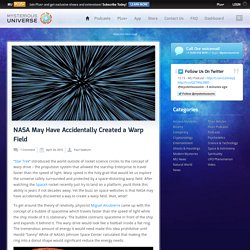
Warp speed is the holy grail that would let us explore the universe safely surrounded and protected by a space-distorting warp field. After watching the SpaceX rocket recently just try to land on a platform, you’d think this ability is years if not decades away. Breaking News: Over-Unity Reactionless Generator Invented In India. “Ere many generations pass; our machinery will be driven by a power obtainable at any point in the universe.” – Nikola Tesla A Reactionless AC Synchronous Generator (RLG) has been invented by Paramahamsa Tewari, electrical engineer and former Executive Director of Nuclear Power Corporation of India.
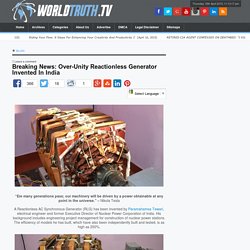
His background includes engineering project management for construction of nuclear power stations. The efficiency of models he has built, which have also been independently built and tested, is as high as 250%. For First Time, Researchers Demonstrate Heat and Sound Are Magnetic. Earlier this month, we reported on research demonstrating that heat propagates as a wave through graphene rather than as vibrations of atoms the way it does in 3-D materials.

In 3-D materials, the collective state of those vibrating atoms is known as phonons. For the first time, researchers at Ohio State University (OSU) have demonstrated that acoustic phonons, which can carry both heat and sound, have magnetic properties that allow them to be manipulated with magnetism. In research published in the journal Nature Materials, the OSU researchers applied a magnetic field equivalent to that inside a magnetic resonance imaging (MRI) device (in this case, the magnet was reported to be fairly powerful at seven Tesla). Noget om ingenting. Detection of mini black holes at the LHC could indicate parallel universes in extra dimensions. (Phys.org)—The possibility that other universes exist beyond our own universe is tantalizing, but seems nearly impossible to test.
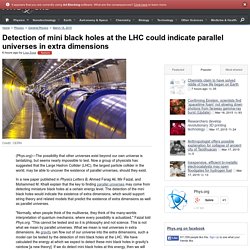
Now a group of physicists has suggested that the Large Hadron Collider (LHC), the largest particle collider in the world, may be able to uncover the existence of parallel universes, should they exist. In a new paper published in Physics Letters B, Ahmed Farag Ali, Mir Faizal, and Mohammed M. The Casimir Effect and Powering Nanotechnology. The Casimir effect is a small attractive and/or repulsive force that acts between two close parallel uncharged conducting plates and for that matter, also on anything on the nanometre and smaller scale at the atomic-sub-atomic level.
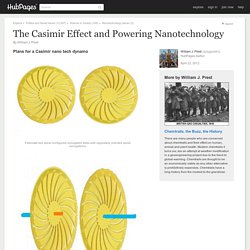
It is arises from the quantum vacuum fluctuations of the electromagnetic field. The effect was predicted from equations worked out by the Dutch physicist Hendrick Casimir in 1948. According to quantum theory, the vacuum continually manifests virtual particles out of the Planck false vacuum, which is in a continuous state of random and chaotic fluctuation. What is the Casimir effect? Northeastern University experimental particle physicists Stephen Reucroft and John Swain put their heads together to write the following answer.

To understand the Casimir Effect, one first has to understand something about a vacuum in space as it is viewed in quantum field theory. Far from being empty, modern physics assumes that a vacuum is full of fluctuating electromagnetic waves that can never be completely eliminated, like an ocean with waves that are always present and can never be stopped. First Observation of the Dynamical Casimir Effect. “One of the most surprising predictions of modern quantum theory is that the vacuum of space is not empty.

In fact, quantum theory predicts that it teems with virtual particles flitting in and out of existence.” So begin Christopher Wilson from Chalmers University in Sweden and friends in their marvellously readable paper about a rather extraordinary piece of science. This maelstrom of quantum activity is far from benign. Physicists have known since 1948 that if two flat mirrors are held close together and parallel with each other, they will be pushed together by these virtual particles. EmDrive. The EmDrive is an experimental spacecraft propulsion device first invented and developed by Roger Shawyer.

The design and concept is currently under investigation by various independent parties. Lockheed Martin's new Compact Fusion Reactor might change humanity forever. This is an invention that might possibly modify the civilization as we know it: A compact fusion reactor presented by Skunk Works, the stealth experimental technology section of Lockheed Martin.
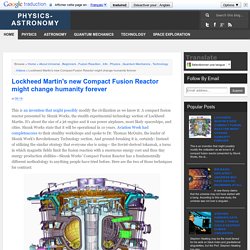
It's about the size of a jet engine and it can power airplanes, most likely spaceships, and cities. Skunk Works state that it will be operational in 10 years. Aviation Week had completeaccess to their stealthy workshops and spoke to Dr. Thomas McGuire, the leader of Skunk Work's Revolutionary Technology section. And ground-breaking it is, certainly: Instead of utilizing the similar strategy that everyone else is using— the Soviet-derived tokamak, a torus in which magnetic fields limit the fusion reaction with a enormous energy cost and thus tiny energy production abilities—Skunk Works' Compact Fusion Reactor has a fundamentally different methodology to anything people have tried before.
Particles accelerate without a push. Some physical principles have been considered immutable since the time of Isaac Newton: Light always travels in straight lines. No physical object can change its speed unless some outside force acts on it. Not so fast, says a new generation of physicists: While the underlying physical laws haven’t changed, new ways of “tricking” those laws to permit seemingly impossible actions have begun to appear. For example, work that began in 2007 proved that under special conditions, light could be made to move along a curved trajectory — a finding that is already beginning to find some practical applications.
Smaller fusion reactors could deliver big gains. No Big Bang? Quantum equation predicts universe has no beginning. (Phys.org) —The universe may have existed forever, according to a new model that applies quantum correction terms to complement Einstein's theory of general relativity. The model may also account for dark matter and dark energy, resolving multiple problems at once. The widely accepted age of the universe, as estimated by general relativity, is 13.8 billion years. In the beginning, everything in existence is thought to have occupied a single infinitely dense point, or singularity. Only after this point began to expand in a "Big Bang" did the universe officially begin. LENR news. Quantum gas goes below absolute zero. PHOTOCREO Michal Bednarek/Thinkstock Temperature in a gas can reach below absolute zero thanks to a quirk of quantum physics. It may sound less likely than hell freezing over, but physicists have created an atomic gas with a sub-absolute-zero temperature for the first time1.
Their technique opens the door to generating negative-Kelvin materials and new quantum devices, and it could even help to solve a cosmological mystery. Black holes generate ‘green’ energy - Technology & science - Space - Space.com. A new study finds that the supermassive black holes at the hearts of some galaxies are the most fuel-efficient engines in the universe. "If you could make a car engine that was as efficient as one of these black holes, you could get about a billion miles out of a gallon of gas," said study team leader Steve Allen of the Kavli Institute for Particle Astrophysics and Cosmology at Stanford University.
"In anyone's book, that would be pretty green. " The finding, made using NASA’s Chandra X-ray Observatory and announced in a media teleconference Monday, is giving scientists insights into how supermassive black holes generate energy and how they affect the galaxies where they make their homes. Black holes are regions of space where gravity is so strong that matter and light can't escape from within the event horizon, a spherical boundary surrounding the black hole. The new study looked at nine supermassive black holes at the centers of elliptical galaxies. Black Hole Drive Could Power Future Starships. By Ryan Anderson on November 19, 2009 Image credit: NASA. No, NASA has not verified an impossible space drive. June 2014 saw excited reports that NASA was working on a faster than light warp drive starship. Astonishingly, weeks later we are being told that NASA has also successfully tested a device which could push along a space vehicle without consuming any propellant.
The nuclear reactor in your basement. By Bob Silberg, NASA Jet Propulsion Laboratory. Super fluid universe. The Scale of the Universe 2. How Many Atoms Are There in the Universe? A billion years after the big bang, hydrogen atoms were mysteriously torn apart into a soup of ions. What's the Total Energy In the Universe? A Universe from Nothing « Astronomical Society. By Alexei V. Filippenko and Jay M.